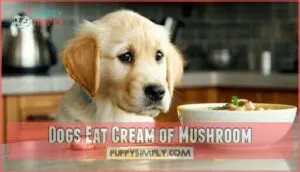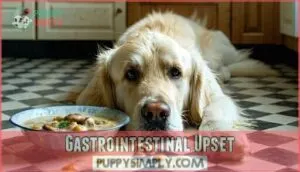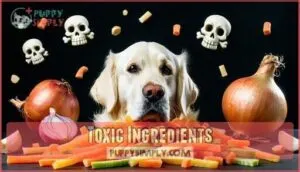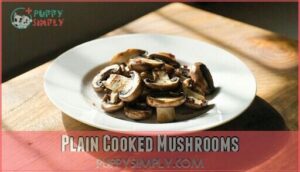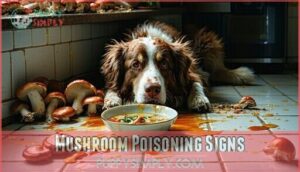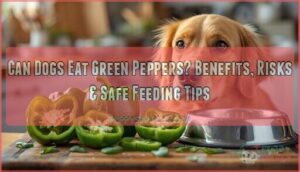This site is supported by our readers. We may earn a commission, at no cost to you, if you purchase through links.
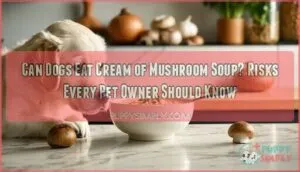
While your pup might give you those irresistible "please share" eyes, this soup contains ingredients that can harm your furry friend.
The high sodium content can lead to dehydration, while dairy elements often cause stomach upset in dogs.
More concerning are onions and garlic, which are toxic to dogs and commonly found in these soups.
Some mushroom varieties might also be problematic for canine digestive systems.
If you’re looking to add variety to your dog’s diet, there are safer options that can satisfy their taste buds without putting their health at risk.
Table Of Contents
- Key Takeaways
- Can Dogs Eat Soup
- Dogs Eat Cream of Mushroom
- Mushroom Soup Risks
- Safe Mushroom Options
- Mushroom Poisoning Signs
- Frequently Asked Questions (FAQs)
- Can dogs eat canned cream of mushroom soup?
- Can dogs eat creamy mushroom sauce?
- Is canned cream of mushroom soup unhealthy?
- What cream is safe for dogs to eat?
- What is the difference between store-bought mushrooms and wild mushrooms?
- How much soup requires emergency vet care?
- Can puppies safely consume small amounts?
- Does soup affect dogs with existing conditions?
- How long do digestive symptoms typically last?
- Can dogs develop mushroom soup preferences?
- Conclusion
Key Takeaways
- Don’t feed your dog cream of mushroom soup—it contains harmful ingredients like onions, garlic, and high sodium.
- Even small amounts can upset your dog’s stomach, causing vomiting, diarrhea, or worse symptoms in sensitive pups.
- Puppies and dogs with conditions like pancreatitis or kidney issues are especially at risk and shouldn’t consume it.
- Stick to safer options like plain cooked mushrooms or homemade dog-friendly soup recipes without toxic ingredients.
Can Dogs Eat Soup
You might wonder if soup, like cream of mushroom, is safe for your dog to eat.
While a small taste likely won’t harm them, many soups contain ingredients that can upset their stomach or even be toxic.
Ingredients in Cream of Mushroom Soup
Cream of mushroom soup contains ingredients that may concern dog owners.
Key components include:
- High Fat Content: Butter and cream can upset your dog’s stomach.
- Lactose Concerns: Dairy often leads to gas or diarrhea.
- Seasoning Dangers: Onion and garlic are toxic to dogs.
- Additives/Preservatives: Canned soups commonly include harmful chemicals, posing dog health risks.
Risks of Feeding Dogs Cream of Mushroom Soup
Now that you know what’s in cream of mushroom soup, let’s talk about why it’s risky for your furry friend.
While the occasional lick might seem harmless, feeding your dog this soup regularly can lead to serious health issues.
| Risk Factor | Consequence | Warning Signs |
|---|---|---|
| High Sodium | Kidney Strain | Excessive thirst |
| Fat Content | Pancreatitis Risk | Vomiting, hunched back |
| Toxic Ingredients | Hemolytic Anemia | Weakness, pale gums |
You’ll want to watch for dog vomiting after consumption. Even store-bought mushrooms require careful preparation to guarantee they’re safe for canine consumption.
Safe Alternatives for Dogs
Now that you understand the risks, let’s look at what you can offer your pup instead.
For dog-safe recipes, try bone broth without onions or garlic. Pumpkin puree makes a great soup base and supports digestion.
Lactose-free options like coconut milk can replace cream. Lean proteins mixed with dog-friendly vegetables create nutritious alternatives that won’t risk mushroom toxicity.
Remember, meeting your dog’s dietary needs doesn’t mean they can’t enjoy tasty meals!
Dogs Eat Cream of Mushroom
If your dog has eaten cream of mushroom soup, don’t panic immediately.
Stay calm and monitor your dog closely; a small taste might be harmless, but watch for signs of distress or unusual behavior.
The amount eaten plays a vital role in determining potential risks.
A small lick might cause minor tummy troubles, while consuming a full bowl could lead to more serious symptoms.
Your dog’s breed and size matter too.
Smaller breeds like Shetland Sheepdogs (around 25 pounds) may show more pronounced reactions to the same amount that barely affects larger dogs.
Watch for immediate reactions like gagging or vomiting small amounts of saliva, which often happen within minutes of soup consumption.
Most dogs who’ve had a taste of mushroom soup will be fine, but you’ll need to monitor symptoms for 24-48 hours.
If your furry friend shows persistent vomiting, diarrhea, or unusual behavior, it’s time to call your vet.
Understanding mushroom toxicity risks is essential for dog owners to guarantee their pets’ safety.
Remember, prevention is better than treatment in dog health.
Mushroom Soup Risks
You’ll need to watch for stomach issues when your dog eats cream of mushroom soup, as ingredients like onions and garlic can be toxic to dogs.
The high salt and fat content can also cause problems ranging from mild digestive upset to more serious conditions like pancreatitis.
Gastrointestinal Upset
After your dog eats cream of mushroom soup, watch for gastrointestinal upset.
Your pup might experience vomiting, diarrhea, and abdominal pain within hours of consumption.
Dog digestion isn’t designed to handle the rich ingredients, leading to nausea symptoms and appetite loss.
Even small amounts can trigger issues in dogs with stomach sensitivity.
If symptoms persist beyond 24 hours, contact your vet for proper diarrhea relief options.
Toxic Ingredients
The danger lurks in what you can’t see—cream of mushroom soup contains several ingredients toxic to your furry friend.
When examining soup labels, you’ll find concerning components:
- Onions and garlic can damage red blood cells, causing anemia and lethargy
- Chives are poisonous to pets, causing similar oxidative damage
- High salt content can lead to sodium ion poisoning
- Dairy components often trigger gastrointestinal upset in dogs
Allergies and Skin Issues
While toxic ingredients pose obvious dangers, your dog’s allergic sensitivities shouldn’t be overlooked.
Many pups develop itchy, red skin or ear infections after consuming dietary allergens found in cream of mushroom soup. Breed predisposition plays a role too, with some dogs more susceptible to food allergies.
Watch for excessive paw licking, scratching, or hair loss – these symptoms often signal that your furry friend needs itch relief and a change in diet.
Switching to natural dog food may reduce exposure to allergens.
Safe Mushroom Options
You can safely offer your dog plain, cooked mushrooms like white button or portobello as occasional treats instead of cream of mushroom soup.
While some mushrooms provide beneficial nutrients for your furry friend, always make certain they’re thoroughly washed, unseasoned, and served in small quantities to avoid digestive upset.
Plain Cooked Mushrooms
While cream of mushroom soup poses risks, plain cooked mushrooms can be a healthy addition to your dog’s diet.
When preparing mushrooms for your furry friend:
- Choose safe varieties like button, shiitake, and chanterelle
- Wash thoroughly to remove dirt and debris
- Cook completely without oils, seasonings, or salt
- Serve in small portions (about 1-2 tablespoons for a medium-sized dog)
Remember that proper mushroom preparation substantially reduces any potential for mushroom toxicity in dogs.
Homemade Dog-Friendly Recipes
While plain cooked mushrooms offer a simple treat, creating your own DIY dog food recipes takes canine nutrition to the next level.
Whip up a homemade dog-friendly mushroom meal by combining cooked button or shiitake mushrooms with lean protein and brown rice.
Guarantee proper nutritional balance and portion control when preparing these recipes. You’ll have peace of mind knowing exactly what ingredients your furry friend is consuming, without any harmful additives found in mushroom soup dogs typically avoid.
Many owners find success with pre-made options available, which can be a convenient alternative to making your own homemade dog food.
Commercial Dog Treats
After learning about homemade recipes, you might want to think about quality commercial dog treats as safe alternatives.
When selecting treats for your furry friend, keep these healthy options in mind:
- Choose single-ingredient treats to minimize risks
- Look for dental treats like Greenies that reduce plaque
- Consider all-natural options like Freshpet Dog Joy
- Try fish-based treats for omega-3 benefits
- Support brands like Campfire Treats with ethical sourcing practices
Always read labels carefully to avoid mushroom toxicity risks. Many owners also choose to buy quality dog treats.
Mushroom Poisoning Signs
You’ll need to recognize the signs of mushroom poisoning in your dog quickly since they can develop within minutes or hours after consumption.
Watch for symptoms like vomiting, diarrhea, excessive drooling, weakness, and confusion, which can indicate your pet has eaten a toxic mushroom variety.
Common Symptoms
While safe mushroom options can benefit your dog, knowing mushroom poisoning symptoms is critical.
Watch for vomiting signs within 15-30 minutes of ingestion, though some symptoms may be delayed up to 24 hours.
Diarrhea, lethargy alert, appetite changes, and abdominal pain often appear first.
More serious mushroom toxicity in dogs can progress to tremors, seizures, and even coma.
Gastrointestinal issues are common, but liver and kidney damage may take 2-3 days to become evident, highlighting the importance of recognizing abdominal pain early.
Treatment for Mushroom Poisoning
After spotting those concerning symptoms in your dog, quick action is essential.
If you suspect mushroom toxicity, veterinary consultation is the first step.
Treatment typically includes activated charcoal to absorb toxins, IV fluids for hydration, antiemetics to control vomiting, and liver support medications.
Your vet will monitor vitals throughout recovery.
For severe cases, intensive care may be necessary.
Never attempt home treatments for suspected pet emergency situations involving mushroom poisoning.
Prevention and Monitoring
After treatment, watch your dog closely for lingering symptoms of mushroom toxicity.
Keep a simple symptom tracking journal noting any changes in behavior, appetite, or bathroom habits.
Maintain proper hydration during recovery and schedule a veterinary follow-up to confirm complete healing.
When reintroducing food, start with bland options and add normal diet gradually.
Some mushrooms offer immune system support due to beneficial compounds.
Remember, prevention is simpler than treatment—keep cream of mushroom soup and wild mushrooms away from curious paws, and focus on complete healing, with proper hydration, and veterinary follow-up.
Frequently Asked Questions (FAQs)
Can dogs eat canned cream of mushroom soup?
Over 70% of pet owners unknowingly feed their dogs harmful food.
No, your dog shouldn’t eat canned cream of mushroom soup as it contains ingredients like onion, garlic, and high sodium that can be toxic.
Can dogs eat creamy mushroom sauce?
Creamy mushroom sauce isn’t recommended for dogs.
It often contains garlic, onions, salt, and dairy that can upset your dog’s stomach or even be toxic.
It’s best to keep these rich foods off your pup’s menu.
Is canned cream of mushroom soup unhealthy?
You’d think something canned would be harmless, but cream of mushroom soup isn’t ideal for your health.
It’s typically high in sodium, contains preservatives, and lacks nutritional value compared to homemade alternatives.
What cream is safe for dogs to eat?
Plain, unsweetened whipped cream or lactose-free options like coconut cream can be safe in small amounts.
Always skip added sugars, flavors, or spices. Moderation is key to avoid upsetting your dog’s stomach.
What is the difference between store-bought mushrooms and wild mushrooms?
Store-bought mushrooms are cultivated, cleaned, and safe when plain.
While wild mushrooms are unpredictable, often toxic, and dangerous.
Stick to store-bought varieties; wild mushrooms can be a risky bet, even for experienced foragers.
How much soup requires emergency vet care?
If your dog ate more than half a cup of cream of mushroom soup, especially if it has garlic, onion, or excess salt, call your vet immediately.
Watch for vomiting, diarrhea, or unusual behavior.
Can puppies safely consume small amounts?
Puppies shouldn’t consume cream of mushroom soup, even in small amounts.
The high sodium, lactose, and potential toxins like garlic or onion powder can upset their sensitive stomachs.
Stick to plain, dog-safe alternatives for their treats.
Does soup affect dogs with existing conditions?
If your dog has medical conditions like pancreatitis or kidney issues, cream of mushroom soup can worsen symptoms due to its high fat and salt content.
Always consult your vet before feeding anything questionable.
How long do digestive symptoms typically last?
Digestive symptoms like mild diarrhea or nausea usually settle within 24-48 hours.
Keep your dog hydrated, watch for persistent issues, and call your vet if symptoms worsen or last longer than expected.
Can dogs develop mushroom soup preferences?
It’s unlikely for dogs to develop a true preference for mushroom soup since their taste buds differ from ours.
However, they might enjoy the smell or texture, but it’s best to avoid encouraging this habit.
Conclusion
Feeding your dog cream of mushroom soup is risky, unhealthy, and unnecessary.
It contains harmful ingredients like onions, garlic, and excessive sodium that can lead to serious health issues.
While your furry friend might beg for a taste, avoid giving in to protect their well-being.
Instead, explore safer and healthier options, such as plain cooked mushrooms or dog-friendly recipes.
Always prioritize your dog’s health and stick to foods designed to meet their dietary needs.


